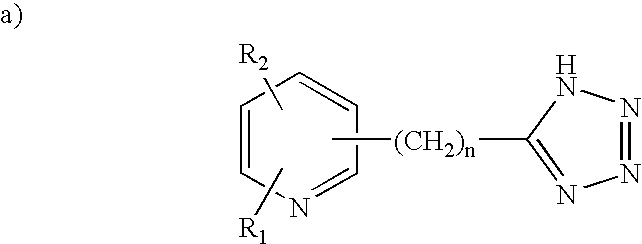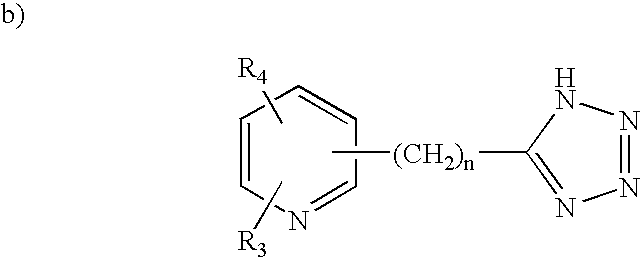Human G protein-coupled receptors and modulators thereof for the treatment of metabolic-related disorders
a technology of human g protein and receptor, which is applied in the direction of peptides, biological material analysis, tissue culture, etc., can solve the problems of lowering the intracellular camp level, and achieve the effect of reducing the level of plasma adiponectin
- Summary
- Abstract
- Description
- Claims
- Application Information
AI Technical Summary
Benefits of technology
Problems solved by technology
Method used
Image
Examples
example 1
A. Endogenous Human GPCRs
Identification of Human GPCRs
[2338]The disclosed endogenous human GPCRs were identified based upon a review of the GenBank™ database information. While searching the database, the following cDNA clones were identified as evidenced below (Table E).
[2339]
TABLE EDisclosedCompleteOpenNucleicAminoHumanAccessionDNAReadingAcidAcidOrphanNumberSequenceFrameSEQ.SEQ.GPCRsIdentified(Base Pairs)(Base Pairs)ID. NO.ID. NO.hRUP8AL121755147,566bp1,152bp12hRUP9AC0113375143,181bp1,260bp34hRUP10AC008745 94,194bp1,014bp56hRUP11AC013396155,086bp1,272bp78hRUP12AP000808177,764bp 966bp910hRUP13AC011780167,819bp1,356bp1112hRUP14AL137118168,297bp1,041bp1314hRUP15AL016468138,828bp1,527bp1516hRUP16AL136106208,042bp1,068bp1718hRUP17AC023078161,735bp 969bp1920hRUP18AC008547117,304bp1,305bp2122hRUP19AC026331145,183bp1,041bp2324hRUP20AL161458163,511bp1,011bp2526hRUP21AC026756156,534bp1,014bp2728hRUP22AC027026151,811bp 993bp2930hRUP23AC007104200,000bp1,092bp3132hRUP24AL355388190,538bp1,12...
example 2
Preparation of Non-Endogenous, Constitutively Activated GPCRS
[2434]Those skilled in the art are credited with the ability to select techniques for mutation of a nucleic acid sequence. Presented below are approaches utilized to create non-endogenous versions of several of the human GPCRs disclosed above. The mutations disclosed below are based upon an algorithmic approach whereby the 16th amino acid (located in the IC3 region of the GPCR) from a conserved proline (or an endogenous, conservative substitution therefor) residue (located in the TM6 region of the GPCR, near the TM6 / IC3 interface) is mutated, preferably to an alanine, histimine, arginine or lysine amino acid residue, most preferably to a lysine amino acid residue.
[2435]1. Transformer Site-Directed™ Mutagenesis
[2436]Preparation of non-endogenous human GPCRs may be accomplished on human GPCRs using, inter alia, Transformer Site-Directed™ Mutagenesis Kit (Clontech) according to the manufacturer instructions. Two mutagenesis p...
example 3
Receptor Expression
[2443]Although a variety of cells are available to the art for the expression of proteins, it is most preferred that mammalian cells be utilized. The primary reason for this is predicated upon practicalities, i.e., utilization of, e.g., yeast cells for the expression of a GPCR, while possible, introduces into the protocol a non-mammalian cell which may not (indeed, in the case of yeast, does not) include the receptor-coupling, genetic-mechanism and secretary pathways that have evolved for mammalian systems—thus, results obtained in non-mammalian cells, while of potential use, are not as preferred as that obtained from mammalian cells. Of the mammalian cells, COS-7, 293 and 293T cells are particularly preferred, although the specific mammalian cell utilized can be predicated upon the particular needs of the artisan.
[2444]a. Transient Transfection
[2445]On day one, 6×106 / 10 cm dish of 293 cells well were plated out. On day two, two reaction tubes were prepared (the p...
PUM
| Property | Measurement | Unit |
|---|---|---|
| Temperature | aaaaa | aaaaa |
| Fraction | aaaaa | aaaaa |
| Fraction | aaaaa | aaaaa |
Abstract
Description
Claims
Application Information
 Login to View More
Login to View More - R&D
- Intellectual Property
- Life Sciences
- Materials
- Tech Scout
- Unparalleled Data Quality
- Higher Quality Content
- 60% Fewer Hallucinations
Browse by: Latest US Patents, China's latest patents, Technical Efficacy Thesaurus, Application Domain, Technology Topic, Popular Technical Reports.
© 2025 PatSnap. All rights reserved.Legal|Privacy policy|Modern Slavery Act Transparency Statement|Sitemap|About US| Contact US: help@patsnap.com



